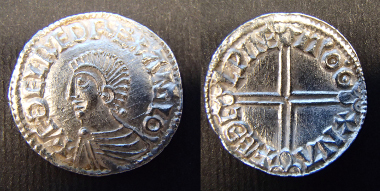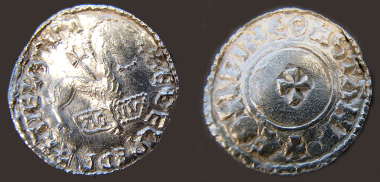March 12, 2015 – On 10 February 2015, on the occasion of the launch of the Treasure Annual Report 2012 by Ed Vaizey, Minister of State for Culture, at the British Museum, the largest Anglo Saxon coin hoard found since the Treasure Act began was announced.
A pile of 697 coins 697 of the coins after cleaning. © The Trustees of the British Museum.
This amazing archaeological hoard of around 5,200 Anglo-Saxon silver pennies, and two cut half pennies, of kings Æthelred II (r.978-1016) and Cnut (r.1016-35) was discovered in the village of Lenborough, Buckinghamshire (2014 T973; BUC-7FE6F2). This discovery highlights the ongoing importance of the Portable Antiquities Scheme and Treasure Act in ensuring that the most important finds are secured for the nation.
Aethelred type 2 Silver penny of Aethelred II, Last Small Cross type, moneyer Edwi of London. © The Trustees of the British Museum.
The coins were found wrapped in a lead sheet and buried in the ground for safekeeping. The coins are of Aethelred II (978-1016) and Cnut (1016-35), and were buried towards the end of Cnut’s reign. The lead wrapping provided protection against the elements while the hoard was in the ground, with the result that the coins are very well preserved.
A Cnut coin, Silver penny of Cnut, Short Cross type, moneyer Godman of London. Around 80% of the coins in the hoard are of this type, but from a wide variety of moneyers and mints. © The Trustees of the British Museum.
The hoard contains coins from over forty different mints around England, and provides a rare source of information on the circulation of coinage at the time the hoard was buried.
Part of the Lenborough Hoard as received at the British Museum before cleaning commenced. © The Trustees of the British Museum.
The hoard was discovered on a metal-detecting rally, and recovered under the guidance of the local Finds Liaison Officer. This important find will reveal a great deal about monetary circulation in late Anglo-Saxon England. Finder Paul Coleman said, ‘When I saw the first few coins I was really excited because I knew I had found a hoard, however the excitement grew and grew as the size and importance of the find became apparent. Ros Tyrrell, the FLO who was in charge of the excavation, was spot on when she said “now I know a little of what Egyptologist Howard Carter must have felt, when he first looked into the tomb of Tutankhamen.”’
Lenborough coin Agnus Dei Silver penny of Aethelred II, Agnus Dei/Last Small Cross mule, moneyer Aethelwine of Stamford. This coin design replaces the image of the king with the Lamb of God. This consciously religious image was part of a wider programme of try to make the English more ‘godly’, in the hope of winning divine intercession against the Vikings, who were sometimes seen as God’s punishment on the English for their lack of Christian piety. © The Trustees of the British Museum.
Chair of Buckinghamshire County Museum Trustees Bob Sutcliffe, commented: ‘This is an incredible find for Buckinghamshire, and a unique opportunity for us to learn more about the origins of Buckinghamshire in Anglo-Saxon times. It would be fantastic to be able to show people that we have nationally important finds being discovered here. Someone in the now tiny village of Lenborough had stasheda massive amount of money, almost 1,000 years ago, and we want to know who, and why! We’re awaiting the official declaration of Treasure and final valuation, before we decide if we are going to try and acquire this hoard – fundraising for such an important find would be a major project for our recently formed Bucks County Museum Trust, but it will give us the chance to try and involve the public on a new scale, and get them really excited about their heritage.’
Under the Treasure Act 1996 there is a legal obligation for finders to report Treasure. Since the advent of the Act the number of finds reported has increased fivefold from 201 cases in 1998 (the first full year of the Act) to 993 in 2013, and 1008 in 2014. If declared Treasure such finds may be acquired by museums, with preference going to the local museum. Of the 990 finds reported Treasure in 2012, 368 were acquired by 100 local museums, so they can be displayed to the public close to where the items were discovered. These include the Bedale, North Yorkshire Hoard of Viking jewellery, weaponry and ingots (2012 T373; YORYM-CEE620) acquired by York Museums Trust, and a Roman silver bracelet from Dalton area, Cumbria (2012 T627; PAS-A7DC11) acquired by the Dock Museum.
Increasingly finders and landowners have waived their right to a reward, enabling museums to acquire Treasure at reduced or no cost. In 2012, 137 parties waived their right to a reward in 93 cases; more than double the number of cases five years ago. Museums have also benefited from funding being made available through the Art Fund, the Headley Trust, The Heritage Lottery Fund, the National Heritage Memorial Fund, and the V&A Purchase Grant fund, which all funded museum acquisitions of Treasure in 2012.
In Room 2 at the British Museum a case is dedicated to displaying recent finds recorded by the Portable Antiquities Scheme or reported Treasure. This allows interesting and important discoveries to be seen in London before they are acquired by local museums.
Aethelred type, Silver penny of Aethelred II, Long Cross type, moneyer Aethelwine of Oxford. © The Trustees of the British Museum.
Another case in Room 68, the Citi Money Gallery, is also often used to display recent finds reported through Treasure and the Portable Antiquities Scheme. A new display of a selection of coins from the Lenborough hoard opens on February 10 to coincide with the launch of the Treasure Annual Report. This will provide some public access to the hoard while it is going through the Treasure process.
For more information on the Portable Antiquities Scheme go to the PAS website.










